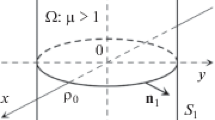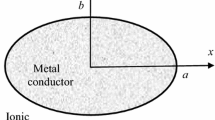Abstract
The aim of this paper is to present a new method of solving particular electrostatic problems. It is based on the superposition of the results obtained in the analysis of the single parts of the problem, to get the solution of a complex geometry. In particular, by means of the generalized solutions, dealing with the hollow cylinder and the end caps separately, the charge distribution, and therefore the capacitance, of a finite cylinder are evaluated.








Similar content being viewed by others
References
Verolino L (1995) Capacitance of a hollow cylinder. Electr Eng 78:201–207
Meixner J (1972) The bahavior of electromagnetic fields at edges. IEEE Trans Antennas Propag 20:341–343
Miano G, Panariello G, Schettino F, Verolino L(1998) The Neumann series: a tool for the analysis of some microstrip structures. Ann Telecommun 53: 104–114
Gradshteyn IS, Ryzhik IM (1980) Tables of integrals, series, and products. Academic Press, New York
Author information
Authors and Affiliations
Corresponding author
Appendices
Appendix 1: Transforms of the Green functions
In this Appendix, a possible way to evaluate Fourier and Hankel transforms (with respect to x and r 0 respectively) of Green's function
is shown.
The Fourier transform can be performed by means of the relevant integral [4]
and the Bessel functions addition theorem
where \( R = \sqrt {r^2 + r_0^2 - 2rr_0 \cos \Phi } \;{\rm and}\;r_0 > r. \) By integrating (24) with respect to Φ between 0 and 2π, it is easy to obtain
The same passages applied to (23) lead to
Substituting (25) in the previous equation, with m=jw, the following expression is obtained
namely
Remembering that [4]
formula (28) becomes
With reference to the Hankel transform of Green's function, interchanging the order of integration, it can be written as
Now let r, r 0 be vectors in the plane (x,y), r′=r 0−r their difference and Φ and Φ′ the angles between r 0 and r′ with x axis respectively.
Translating the axes as
relation (29), after the variable change, becomes:
The integral in the square brackets in (30) can be evaluated using again the Gegenbauer addition theorem, in the Graf form [4]:
By means of the former relation, expression (30) becomes
Finally, remembering that
relation (32) simplifies as [4]
Appendix 2: Capacitance of a disc of negligible thickness
In this Appendix, the capacitance with respect to infinity of a metallic disc of negligible thickness is analytically evaluated. The boundary conditions on the metallic disc lead to
V being the potential of the disc. Using (2) in the particular case p=1/2 to expand the charge distribution, and expressing Green's function in terms of Hankel transform, upon a projection onto the basis function themselves, the following algebraic system is obtained
where the coefficient matrix is defined as
Since integral (34) is not zero only when m equals n, b 1 can be analytically evaluated as
and it is readily obtained
Rights and permissions
About this article
Cite this article
Falco, S., Panariello, G., Schettino, F. et al. Capacitance of a finite cylinder. Electr Eng 85, 177–182 (2003). https://doi.org/10.1007/s00202-003-0160-z
Received:
Accepted:
Published:
Issue Date:
DOI: https://doi.org/10.1007/s00202-003-0160-z




